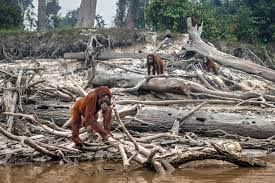Photo: courtesy of NewYork Times
Long-term changes in weather patterns has proven to be a major danger to biodiversity (animals, plants, fungi and micro-organisms). It has damaged countless ecosystems around the planet, causing species extinction, more intense storms, greater temperatures, increased drought, and health hazards, among other things. Climate and biodiversity are often linked. It frequently has a negative impact because the climatic changes are caused by human activities such as industrialization, as well as natural factors such as variations in solar activity, volcanic activity, and changes in the earth's orbit, among many others, whereas biodiversity strives to ensure climate stabilization.
Photo: courtesy of google
Despite the prevailing circumstances, biodiversity still remains a critical aspect in maintaining climate mitigation, which in turn results in the creation of an ecofriendly environment. In the efforts to protect biodiversity, climate change can also be minimized by reducing the concentration of carbon in the atmosphere through a process known as the carbon cycle, and later on incorporating it into living things. Through the carbon cycle, plants, in this case, acquire carbon through photosynthesis and later on pass it on to animals (human beings) in the form of carbohydrates.
On the other hand, ecosystems such as forests (trees) contribute to climate stability by replenishing ground water supplies as a result of moisture retained in the roots and stems of the trees and recycling water vapor back into the sky, resulting in rainfall. This is frequently beneficial during times of drought.
Forests (trees) are one of the most important components in climate stability. They aid in the prevention of the following:
1. Wildfires: Planting of Mediterranean cypress trees in the Mediterranean region as they act as natural firebreaks
2. Heatwaves: Replacing air conditioning with tree planting for a cooler climate helps to reduce carbon emissions in the atmosphere.
3. Coastal flooding: Planting mangroves and coral reefs will help lessen the likelihood of seawater intruding into land.
4. Sandstorms: By preventing deforestation and planting more trees, desertification will reduce hence no room for sand storms.
The world as a whole will benefit in all imaginable ways (social and economic) as ecosystems will change for the better thanks to the United Nations Environment Programme (UNEP) efforts to adopt the economy-based adaptation strategy where biodiversity functions as a defense tool against climate change.









Nice Article I love how you have explained out .
ReplyDeleteGood one
ReplyDeleteGreat article
ReplyDeleteNice article
ReplyDeleteNice one
ReplyDeleteWell articulated 💯
ReplyDeleteAmazing
ReplyDeleteEcosystem and mother nature are so important
ReplyDeleteGood job
Great article.. and well explained...
ReplyDeleteNice Article
ReplyDeleteIt's high time we took care of our environment
ReplyDeleteInteresting
ReplyDeleteimpressive
ReplyDeleteFactual
ReplyDeleteThis is a nice article Sue
ReplyDeleteNice article
ReplyDeletewow
ReplyDeleteNice article💫
ReplyDeleteNice one
ReplyDeleteCould not have been said any better
ReplyDeleteThis comment has been removed by the author.
ReplyDeleteNice one
ReplyDeleteGreat article 😊
ReplyDeleteSue si this is nice
ReplyDeleteNice piece sue
ReplyDeleteNice article.
ReplyDeleteGreat
ReplyDelete